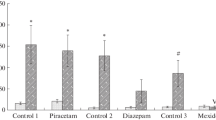Summary
The effect of physostigmine on EEG activity and conditioning was studied in rats. Theta activity develops in the hippocampus of curarized or freely moving unanesthetized animals 3–7 min after i.p. injection of 1 mg/kg physostigmine salicylate, attains maximum after 10 min and disappears after 30–60 min. Gradual impairment of learning corresponds to the development of theta waves. One-trial acquisition of a passive avoidance reaction (avoiding a compartment with electrifiable floor) is completely suppressed 10 min after application of 1.0 or 0.5 mg/kg physostigmine and to a lesser extent even after 0.2 mg/kg physostigmine. No retention of this reaction was found 24 h after onetrial learning when physostigmine (0.5 mg/kg) was applied 8 min before the retention test. On the contrary the same physostigmine dose does not impair the retention of an overtrained (four times) passive avoidance reaction. Also retention of an overlearned active avoidance reaction (running to the safe part of the apparatus is not affected by 0.5 mg/kg physostigmine and only partly impaired by 1 mg/kg physostigmine. The functional significance of the hippocampal theta activity is discussed.
Similar content being viewed by others
References
Adey, W. R., D. O. Walter and C. E. Hendrix: Computer techniques in correlation and spectral analyses of cerebral slow waves during discriminative behavior. Exp. Neurol. 3, 501–524 (1961).
Bohdanecký, Z., T. Weiss and E. Fifková: The influence of neocortical and hippocampal spreading depression on “theta rhythm” elicited by physostigmine. 1962 (in press).
Bradley, P. B., A. N. Nicholson: The effects of drugs on the electrical activity of the hippocampus. Colloque internat. du CNRS sur Physiologie de l'Hippocampe, Montpellier 1961.
Bureš, J., O. Burešová and T. Weiss: Functional consequences of hippocampal spreading depression. Physiol. bohemoslov. 9, 219–227 (1960).
- - - E. Fifková and Z. Bohdanecký: Experimental study of the role of hippocampus in conditioning and memory functions. Colloque internat. du CNRS sur Physiologie de l'Hippocampe, Montpellier 1961.
Cardo, D.: Action de l'amphétamine dextrogyre et de l'éserine sur un conditionnement de fuite et sur les phénomènes de discrimination. J. Physiol. (Paris) 5, 845–860 (1959).
Funderburk, W. H., and T. J. Case: Effect of parasympathetic drugs on conditioned response. J. Neurophysiol. 10, 179–187 (1947).
Grastyán, E.: The hippocampus and higher nervous activity. In: The central nervous system and behavior. Transactions of the 2nd Macy Conference 1959, pp. 119–205.
Green, J. D., and A. A. Arduini: Hippocampal electrical activity in arousal. J. Neurophysiol. 17, 533–557 (1954).
—, D. S. Maxwell, W. J. Schindler and C. Stumpf: Rabbit EEG “theta” rhythm: its anatomical source and relation to activity in single neurons. J. Neurophysiol. 23, 403–420 (1960).
MacLean, P. D.: The lymbic system with respect to selfpreservation and preservation of the species. J. nerv. ment. Dis. 127, 1–11 (1958).
Mayer, C., u. C. Stumpf: Die Physostigminwirkung auf die Hippocampus-Tätigkeit nach Septumläsionen. Naunyn-Schmiedeberg's Arch. exp. Path. Pharmak. 234, 490–500 (1958).
Michelson, M. J.: Pharmacological evidences of the role acetylcholine in the higher nervous activity of man and animals. Activ. nerv. sup. (Praha) 3, 140–147 (1961).
Morell, F.: Electrophysiological contributions to the neural basis of learning. Physiol. Rev. 41, 443–494 (1961).
Penfield, W., and B. Milner: Memory deficit produced by bilateral lesions in the hippocampal zone. Arch. Neurol. Psychiat. (Chic.) 79, 475–497 (1958).
Pfeiffer, C. C., and E. H. Jenney: A component of pharmacological action which inhibits the conditioned response and counteracts schizophrenia. 20th Int. Congr. of Physiol., Brussels 1956, Abstracts of Communications, pp. 723–724.
— —: The inhibition of the conitioned response and the counteraction of schizophrenia by muscarinic stimulation of the brain. Ann. N.Y. Acad. Sci. 66, 753–764 (1957).
Popova, E. N.: Some data on the effect of eserine on the cerebral cortex of albino rats (in Russian). Bull. exp. Biol. Med. 51, 2, 72–78 (1961).
Rensch, B., u. H. Rahmann: Einfluß des Pervitins auf das Gedächtnis von Goldhamstern. Pflügers Arch. ges. Physiol. 271, 693–704 (1960).
Sailer, S., u. C. Stumpf: Beeinflußbarkeit der rhinencephalen Tätigkeit des Kaninchens. Naunyn-Schmiedeberg's Arch. exp. Path. Pharmak. 231, 63–77 (1957).
Thomas, G. J., and L. S. Otis: Effects of rhinencephalis lesions on conditioning of avoidance responses in the rat. J. comp. physiol. Psychol. 51, 130–134 (1958a).
— —: Effects of rhinencephalic lesions on maze learning in rats. J. comp. physiol. Psychol. 51, 161–166 (1958b).
Author information
Authors and Affiliations
Rights and permissions
About this article
Cite this article
Bureš, J., Bohdanecký, Z. & Weiss, T. Physostigmine induced hippocampal theta activity and learning in rats. Psychopharmacologia 3, 254–263 (1962). https://doi.org/10.1007/BF00411366
Received:
Issue Date:
DOI: https://doi.org/10.1007/BF00411366



